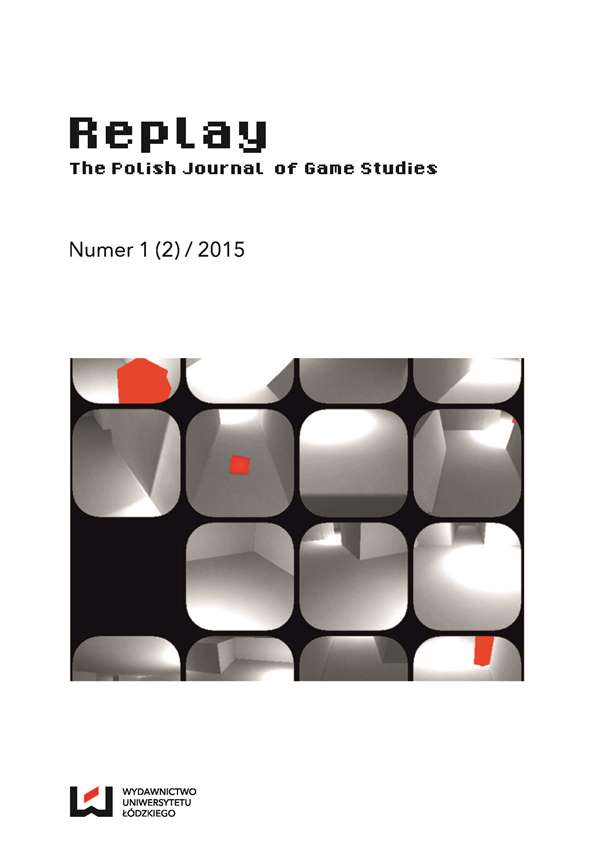City beyond the city: the notion of contemporary flaneurism in video games
DOI:
https://doi.org/10.18778/2391-8551.02.02Keywords:
exploration video game, city space, flâneur, slow space, video game space, motion in video gamesAbstract
This article is a comparative analysis between the exploration video game genre and the theories of contemporary city space. It focuses predominantly on confronting spatial experience of the city space with video game space. This comparison uses the concept of flâneur and slow space to show how these two phenomena are manifested in virtual environments. In the exploration video games, such as "Dear Esther" and "Proteus", the author sees an interesting alternative to overcomplicated gameplay and games overloaded with unnecessary visual information.
References
Caillois, Roger. 1997, Gry i ludzie, przeł. Anna Tatarkiewicz, Maria Żurowska, Warszawa: Volumen.
Google Scholar
Certeau, Michel de. 2008, Wynaleźć codzienność. Sztuki działania, przeł. Katarzyna Thiel-Jańczuk, Kraków: Wydawnictwo Uniwersytetu Jegiellońskiego.
Google Scholar
Dovey, Jon, Kennedy, Helen W. 2011, Kultura gier komputerowych, Kraków: Wydawnictwa Uniwersytetu Jagiellońskiego.
Google Scholar
Frydryczak, Beata. 1998, Okiem przechodnia: ulica jako przestrzeń estetyczna, w: J. S. Wojciechowski, A. Zeidler-Janiszewska (red.), Formy estetyzacji przestrzeni publicznej, Warszawa: Instytut Kultury, s. 101–115.
Google Scholar
Jenkins, Henry. 2004, Game design as narrative architecture, w: First Person: New Media as Story, Performance, and Game, red. N. Wardrip-Fruin, P. Harrigan, Cambridge, MA: MIT Press.
Google Scholar
Lynch, Kevin. 1960, The Image of the City, Cambrige/Massachsetts/London: The MIT Press.
Google Scholar
Nitsche, Michael. 2008, Video Game Spaces. Image, Play, and Structure in 3D Game Worlds, Cambridge/Massachusetts/London: The MIT Press.
Google Scholar
DOI: https://doi.org/10.7551/mitpress/9780262141017.001.0001
Paetzold, Heinz. Polityka przechadzki. Flâneur Benjamina i potem, tłum. E. Mikina, w: Formy estetyzacji przestrzeni publicznej, red. J. S. Wojciechowski, A. Zeidler – Janiszewska, Warszawa 1998, s. 117–129.
Google Scholar
Rawlinson, Christopher J., Guaralda, Mirko. Chaos and creativity of play: designing emotional engagement in public spaces, 2012, {pilk PDF; dostęp offline: 8 VIII 2013}.
Google Scholar
Rawlinson, Christopher, Guaralda, Mirko. 2012, Chaos and creativity of play: designing emotional engagement in public spaces, w: Out of control: Proceedings of 8th International Design and Emotion Conference: Out of Control, red. J. Brassett, P. Hekkert, G. Ludden, M. Malpass, J. McDonnell, Janet, University of the Arts London, Central Saint Martins College of Art & Design, London, United Kingdom, pp. 1–12.
Google Scholar
Rewers, Ewa. 2008, Po-wolna przestrzeń, w: Krystyna Wilkoszewska (red.), Czas przestrzeni, Kraków: Towarzystwo Autorów i Wydawców Prac Naukowych Universitas.
Google Scholar
Symotiuk, Stefan. 1997, Filozofia i genius loci, Warszawa: Instytut Kultury.
Google Scholar
Yi-Fu Tuan. 1987, Przestrzeń i miejsce, przeł. A. Morawińska, Warszawa: Państwowy Instytut Wydawniczy.
Google Scholar
Ubisoft Montreal, 2007–2013, seria Assassin’s Creed [PC], Ubisoft.
Google Scholar
The Chinese Room, 2012, Dear Esther [PC], The Chinese Room.
Google Scholar
The Fullbright Company, 2013, Gone Home [PC], The Fullbright Company.
Google Scholar
Rockstar North, 1997–2015, seria Grand Theft Auto [PC], Rockstar Games.
Google Scholar
EA Digital Illusions CE, 2008, Mirror’s Edge [PC], Electronic Arts.
Google Scholar
Ed Key and David Kanaga, 2013, Proteus [PC], Ed Key and David Kanaga.
Google Scholar
Bethesda Game Studios, 2011, The Elder Scrolls V: Skyrim [PC], Bethesda Softworks.
Google Scholar
Downloads
Published
How to Cite
Issue
Section
License

This work is licensed under a Creative Commons Attribution-NonCommercial-NoDerivatives 3.0 Unported License.










